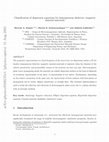Papers by Akhlesh Lakhtakia
We consider the strong-property-fluctuation theory (SPFT) for linear bianisotropic mediums based ... more We consider the strong-property-fluctuation theory (SPFT) for linear bianisotropic mediums based on ellipsoidal distribution topology. Implementations of the SPFT are presented for three choices of the covariance function. The SPFT is then applied to estimate the effective constitutive parameters of two types of homogenised composite medium: a chiroferrite medium and a reciprocal biaxial bianisotropic medium. The influences of the component
Photonic Metamaterials, 2007
We studied trends in three measures of both duration and average speed of optical videopulses tra... more We studied trends in three measures of both duration and average speed of optical videopulses transmitted through chiral sculptured thin films (STFs). The films, a class of nanoengineered materials which consist of parallel helical nanowires grown on a substrate, were taken to be linear or nonlinear with an intensity-dependent refractive index. We used a finite-difference algorithm to compute the evolution
Physical Review B, 1999
ABSTRACT
Journal of Vacuum Science & Technology B: Microelectronics and Nanometer Structures, 2004
Selective growth of sculptured nanowires on microlithographic lattices. [Journal of Vacuum Scienc... more Selective growth of sculptured nanowires on microlithographic lattices. [Journal of Vacuum Science & Technology B: Microelectronics and Nanometer Structures 22, 3426 (2004)]. Mark W. Horn, Matthew D. Pickett, Russell Messier, Akhlesh Lakhtakia. Abstract. ...
Journal of Vacuum Science & Technology B: Microelectronics and Nanometer Structures, 2000
With the microelectronics industry moving relentlessly towards decreasing feature sizes and incre... more With the microelectronics industry moving relentlessly towards decreasing feature sizes and increasingly stringent tolerance levels, an urgent need exists to reduce crosstalk, power dissipation, and propagation delay due to increased resistivity of metal lines and ...
We report numerical time-domain simulations that reveal the continued reflection of an axially pr... more We report numerical time-domain simulations that reveal the continued reflection of an axially propagating optical pulse as it travels through a dielectric thin-film helicoidal bianisotropic medium (TFHBM) half- space, when the handedness of the pulse is the same as that of the medium. This phenomenon is dubbed pulse bleeding, and is a central feature of the spatio-temporal anatomy of the
Nanophotonics II, 2008
At optical wavelengths, a chiral sculptured thin film (CSTF) may be viewed as a unidirectionally ... more At optical wavelengths, a chiral sculptured thin film (CSTF) may be viewed as a unidirectionally nonhomogeneous continuum that locally possesses orthorhombic symmetry and globally is structurally chiral. The circular Bragg phenomenon exhibited by CSTFs (i.e., a structurally right/left-handed CSTF of sufficient thickness almost completely reflects right/left-circularly polarized light which is normally incident, but left/right-circularly polarized light is reflected very little,
IEEE Transactions on Microwave Theory and Techniques, 1981
Introduction to Complex Mediums for Optics and Electromagnetics, 2003
... [42] JB Pendry, Negative refraction makes a perfect lens, Phys Rev Lett 85 (2001), 3966-3969.... more ... [42] JB Pendry, Negative refraction makes a perfect lens, Phys Rev Lett 85 (2001), 3966-3969. Page 400. 362 Akhlesh Lakhtakia. Martin W. McCall, and Werner S. Weiglhofer [43] ZM Zhang and CJ Fu, Unusual photon tunneling in the presence of a layer with a negative ...
IEEE Transactions on Antennas and Propagation, 1984
The inverse black body radiation problem, involving the determination of the area-temperature dis... more The inverse black body radiation problem, involving the determination of the area-temperature distribution of a black body from its measured radiated power spectrum has recently been solved by Bojarski (1982). A simplified result restricted to microwave frequencies has also become available recently. The present approach, which is similar to Bojarski's but much simpler, is restricted to submillimeter waves and/or low
Journal of the European Optical Society: Rapid Publications, 2007
Surface waves, named here as Dyakonov-Tamm waves, can exist at the planar interface of an isotrop... more Surface waves, named here as Dyakonov-Tamm waves, can exist at the planar interface of an isotropic dielectric material and a chiral sculptured thin film (STF). Due to the periodic nonhomogeneity of a chiral STF, the range of the refractive index of the isotropic material is smaller but the range of the propagation direction in the interface plane is much larger, in comparison to those for the existence of Dyakonov waves at the planar interface of an isotropic dielectric material and a columnar thin film.
Optics express, Jan 15, 2008
We studied a metasurface constituted as a periodic array of semiconductor split-ring resonators. ... more We studied a metasurface constituted as a periodic array of semiconductor split-ring resonators. The resonance frequencies of the metasurface excited by normally incident light were found to be continuously tunable in the terahertz regime through an external magnetostatic field of suitable orientation. As such metasurfaces can be assembled into 3D metamaterials, the foregoing conclusion also applies to metamaterials comprising semiconductor split-ring resonators.
Physical review. E, Statistical physics, plasmas, fluids, and related interdisciplinary topics, 1994
A constraint on linear, homogeneous, constitutive relations is presented. It does not affect the ... more A constraint on linear, homogeneous, constitutive relations is presented. It does not affect the sources and the primitive fields, its effect being solely on the induction fields. As the Maxwell postulates are satisfied without question, its use amounts to a simplification of the description of linear, homogeneous, magnetoelectric media. The constraint is in complete harmony with the covariant character of
Physics Letters A, 2005
The propagation of electromagnetic plane waves with negative phase velocity (NPV) in the ergosphe... more The propagation of electromagnetic plane waves with negative phase velocity (NPV) in the ergosphere of a rotating black hole has recently been reported. A comparison of NPV propagation and superradiance is presented. We show that, although both phenomenons involve negative energy densities, there are two significant differences between them.
Physics Letters A, 2005
The diffraction of electromagnetic plane waves by a rectangular grating formed by discrete steps ... more The diffraction of electromagnetic plane waves by a rectangular grating formed by discrete steps in the interface of a homogeneous, isotropic, linear, negative phasevelocity (negative index) material with free space is studied using the semi-analytic C method. When a nonspecular diffracted order is of the propagating type, coupling to that order is significantly larger for a negative index material than for conventional material.
Optics Communications, 2006
The differential method (also called the C method) is applied to the diffraction of linearly pola... more The differential method (also called the C method) is applied to the diffraction of linearly polarized plane waves at a periodically corrugated boundary between vacuum and a linear, homogeneous, uniaxial, dielectric–magnetic medium characterized by hyperbolic dispersion equations. Numerical results for sinusoidal gratings are presented and compared with those obtained by means of the Rayleigh method, showing that both the differential

Journal of the Optical Society of America. A, Optics, image science, and vision, 2006
The geometric representation at a fixed frequency of the wave vector (or dispersion) surface omeg... more The geometric representation at a fixed frequency of the wave vector (or dispersion) surface omega(k) for lossless, homogeneous, dielectric-magnetic uniaxial materials is explored for the case when the elements of the relative permittivity and permeability tensors of the material can have any sign. Electromagnetic plane waves propagating inside the material can exhibit dispersion surfaces in the form of ellipsoids of revolution, hyperboloids of one sheet, or hyperboloids of two sheets. Furthermore, depending on the relative orientation of the optic axis, the intersections of these surfaces with fixed planes of propagation can be circles, ellipses, hyperbolas, or straight lines. The understanding obtained is used to study the reflection and refraction of electromagnetic plane waves due to a planar interface with an isotropic medium.
IEEE Photonics Journal, 2010
Setting up an empirical model of optical sensing to exploit the circular Bragg phenomenon display... more Setting up an empirical model of optical sensing to exploit the circular Bragg phenomenon displayed by chiral sculptured thin films (CSTFs), we considered a CSTF with and without a central twist defect of π/2 radians. The circular Bragg phenomenon of the defect-free CSTF, and the spectral hole in the co-polarized reflectance spectrum of the CSTF with the twist defect, were both found to be acutely sensitive to the refractive index of a fluid which infiltrates the void regions of the CSTF. These findings bode well for the deployment of CSTFs as optical sensors.

Journal of Photonics for Energy, 2010
Chirality extends the class of negatively refracting metamaterials by endowing a richer palette o... more Chirality extends the class of negatively refracting metamaterials by endowing a richer palette of electromagnetic properties. Chiral metamaterials can support negative refraction, which must be assessed in light of the closely related phenomenons of negative phase velocity and counterposition. Two categories of chiral metamaterials are being examined these days: (a) homogeneous and homogenizable chiral materials, as exemplified by isotropic chiral materials, Faraday chiral materials, and materials with simultaneous mirror-conjugated and racemic chirality characteristics; and (b) structurally chiral materials, as exemplified by helicoidal bianisotropic materials and ambichiral materials. The planewave response of a half-space occupied by a chiral metamaterial is complex, and important distinctions between negative refraction, negative phase velocity, and counterposition emerge. C 2010 Society of Photo-Optical Instrumentation Engineers.









Uploads
Papers by Akhlesh Lakhtakia